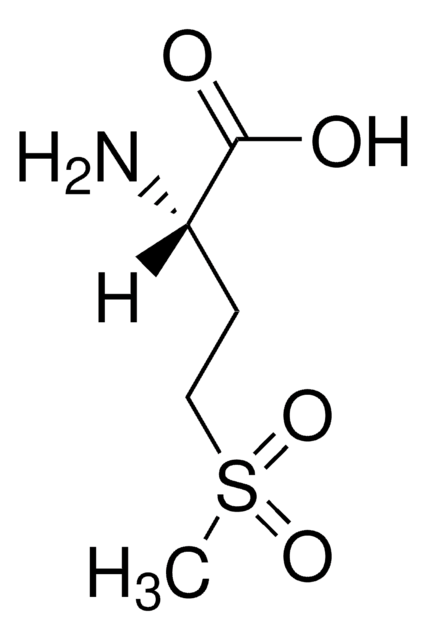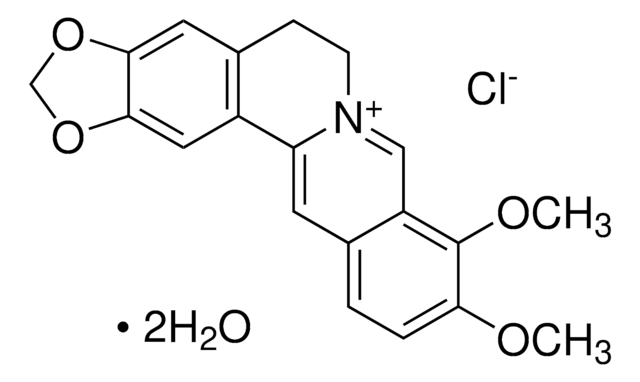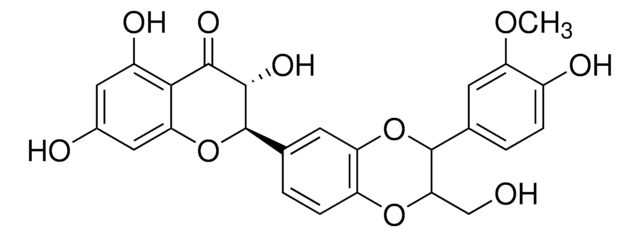Key Documents
PHL80429
Dihydroberberine
phyproof® Reference Substance
Synonim(y):
5,8-Dihydro-9,10-dimethoxy-6H-benzo[g]-1,3-benzodioxolo[5,6-a]quinolizine, Dihydroumbellatine
About This Item
Polecane produkty
klasa czystości
primary reference standard
linia produktu
phyproof® Reference Substance
Próba
≥90.0% (HPLC)
producent / nazwa handlowa
PhytoLab
format
neat
InChI
1S/C20H19NO4/c1-22-17-4-3-12-7-16-14-9-19-18(24-11-25-19)8-13(14)5-6-21(16)10-15(12)20(17)23-2/h3-4,7-9H,5-6,10-11H2,1-2H3
Klucz InChI
FZAGOOYMTPGPGF-UHFFFAOYSA-N
Opis ogólny
Zastosowanie
- (+)-Abscisic acid in plant stress hormone research: Investigated the cloning of CAT genes in Satsuma mandarin and their expression characteristics in response to environmental stress and arbuscular mycorrhizal fungi. This research highlights the crucial role of (+)-abscisic acid in mediating plant responses to abiotic stresses, demonstrating its utility as a high-purity biochemical assay reagent for studying stress response signaling in plants (Liu et al., 2024).
- (+)-Abscisic acid in biochemical assays: The physiological and biochemical response of Styrax tonkinensis seedlings to waterlogging stress was analyzed. This research underscores the importance of (+)-abscisic acid in biochemical assays aimed at understanding how plants cope with water stress, reinforcing its role in signal transduction studies related to plant survival mechanisms under adverse conditions (Chen et al., 2024).
- Synthetic (+)-abscisic acid in plant biology: Examined RNA splicing and its effects on the postharvest physiological deterioration of cassava storage roots. The study discusses the involvement of (+)-abscisic acid in plant biology, particularly in how it influences postharvest changes through its role in signaling pathways that control physiological processes in plants (Gu et al., 2024).
Informacje prawne
Hasło ostrzegawcze
Danger
Zwroty wskazujące rodzaj zagrożenia
Zwroty wskazujące środki ostrożności
Klasyfikacja zagrożeń
Acute Tox. 2 Oral
Kod klasy składowania
6.1A - Combustible acute toxic Cat. 1 and 2 / very toxic hazardous materials
Klasa zagrożenia wodnego (WGK)
WGK 3
Temperatura zapłonu (°F)
Not applicable
Temperatura zapłonu (°C)
Not applicable
Wybierz jedną z najnowszych wersji:
Masz już ten produkt?
Dokumenty związane z niedawno zakupionymi produktami zostały zamieszczone w Bibliotece dokumentów.
Nasz zespół naukowców ma doświadczenie we wszystkich obszarach badań, w tym w naukach przyrodniczych, materiałoznawstwie, syntezie chemicznej, chromatografii, analityce i wielu innych dziedzinach.
Skontaktuj się z zespołem ds. pomocy technicznej







